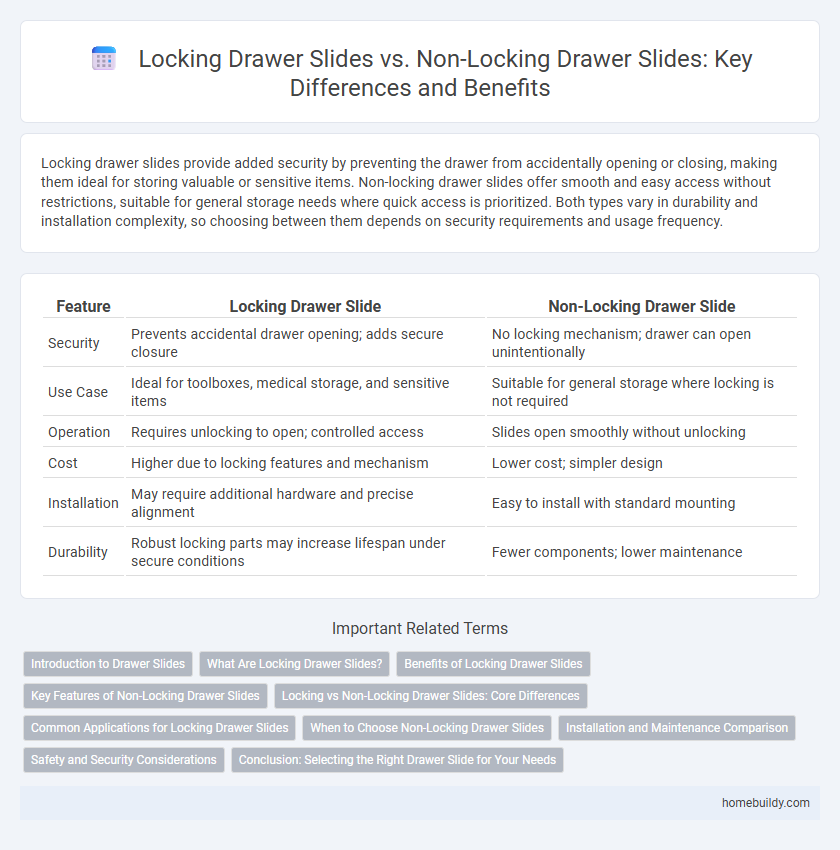Locking drawer slides provide added security by preventing the drawer from accidentally opening or closing, making them ideal for storing valuable or sensitive items. Non-locking drawer slides offer smooth and easy access without restrictions, suitable for general storage needs where quick access is prioritized. Both types vary in durability and installation complexity, so choosing between them depends on security requirements and usage frequency.
Table of Comparison
| Feature | Locking Drawer Slide | Non-Locking Drawer Slide |
|---|---|---|
| Security | Prevents accidental drawer opening; adds secure closure | No locking mechanism; drawer can open unintentionally |
| Use Case | Ideal for toolboxes, medical storage, and sensitive items | Suitable for general storage where locking is not required |
| Operation | Requires unlocking to open; controlled access | Slides open smoothly without unlocking |
| Cost | Higher due to locking features and mechanism | Lower cost; simpler design |
| Installation | May require additional hardware and precise alignment | Easy to install with standard mounting |
| Durability | Robust locking parts may increase lifespan under secure conditions | Fewer components; lower maintenance |
Introduction to Drawer Slides
Locking drawer slides provide secure closure by engaging a mechanical lock that prevents the drawer from accidentally opening, enhancing safety and stability in demanding environments. Non-locking drawer slides offer smooth and flexible movement without a locking mechanism, making them ideal for everyday use where ease of access is prioritized. Understanding the differences ensures optimal selection based on application needs, such as security requirements or frequency of drawer access.
What Are Locking Drawer Slides?
Locking drawer slides are specialized hardware components designed to secure drawers in a closed or extended position, preventing unwanted movement during use or transport. These slides feature integrated locking mechanisms that engage automatically or manually, enhancing safety and stability in applications such as tool chests, mobile cabinets, and industrial storage units. Unlike non-locking drawer slides, locking slides provide controlled retention, reducing accidental drawer openings and protecting contents from spillage or damage.
Benefits of Locking Drawer Slides
Locking drawer slides provide enhanced security by preventing drawers from accidentally opening, which is essential for safeguarding valuable or sensitive items. They improve safety in environments prone to vibrations or movement, such as in vehicles or industrial settings. This feature also minimizes the risk of drawer contents spilling out, maintaining organized and secure storage.
Key Features of Non-Locking Drawer Slides
Non-locking drawer slides provide smooth, consistent movement with easy installation and minimal maintenance requirements, making them ideal for everyday use in residential and commercial furniture. These slides maintain reliable support without locking mechanisms, enabling quick access and seamless drawer operation. Their simple design reduces cost and weight compared to locking drawer slides, enhancing overall functionality for standard storage needs.
Locking vs Non-Locking Drawer Slides: Core Differences
Locking drawer slides secure drawers in a fixed position to prevent unintended opening or movement, enhancing safety and stability in applications like tool storage or industrial equipment. Non-locking drawer slides allow smooth, unrestricted opening and closing, offering easier access and flexibility for general-use furniture or cabinetry. The core difference lies in the locking mechanism, which adds a layer of security and control absent in non-locking slides.
Common Applications for Locking Drawer Slides
Locking drawer slides are commonly used in applications requiring secure storage and controlled access, such as medical cabinets, tool chests, and office filing systems. These slides prevent unintended drawer opening during transport or sudden movements, offering enhanced safety and security in mobile or high-traffic environments. Unlike non-locking slides, locking variants ensure drawers remain firmly closed until manually released, making them ideal for sensitive or valuable contents.
When to Choose Non-Locking Drawer Slides
Non-locking drawer slides are ideal for applications requiring smooth, frequent access without the need for securing the drawer in place. They offer effortless opening and closing in furniture such as desks, kitchen cabinets, and utility drawers where locking mechanisms are unnecessary. Choosing non-locking slides enhances convenience and reduces hardware complexity in environments with low-security demands.
Installation and Maintenance Comparison
Locking drawer slides require precise alignment during installation to ensure the locking mechanism functions correctly, which may increase setup time compared to non-locking drawer slides that have straightforward installation processes. Maintenance for locking slides involves periodic checks and lubrication of the locking components to prevent jamming, whereas non-locking slides typically need less frequent attention, focusing mainly on cleaning and basic lubrication. Proper installation and routine upkeep of locking drawer slides enhance durability and safety, while non-locking slides offer ease of maintenance with fewer mechanical parts prone to wear.
Safety and Security Considerations
Locking drawer slides provide enhanced safety by preventing accidental drawer opening during motion or heavy vibrations, reducing the risk of injuries and spills. Non-locking drawer slides lack secure retention, potentially allowing drawers to slide open unintentionally, which can compromise the security of sensitive contents. For environments requiring strict safety protocols or secure storage, locking drawer slides are the preferred choice to ensure controlled access and avoid hazards.
Conclusion: Selecting the Right Drawer Slide for Your Needs
Choosing between locking and non-locking drawer slides depends on the specific security and stability requirements of your application. Locking drawer slides provide enhanced safety by preventing unintended drawer movement, ideal for environments requiring secure storage. Non-locking slides offer smoother operation and are suitable for general use where ease of access is prioritized over security.
locking drawer slide vs non-locking drawer slide Infographic

 homebuildy.com
homebuildy.com